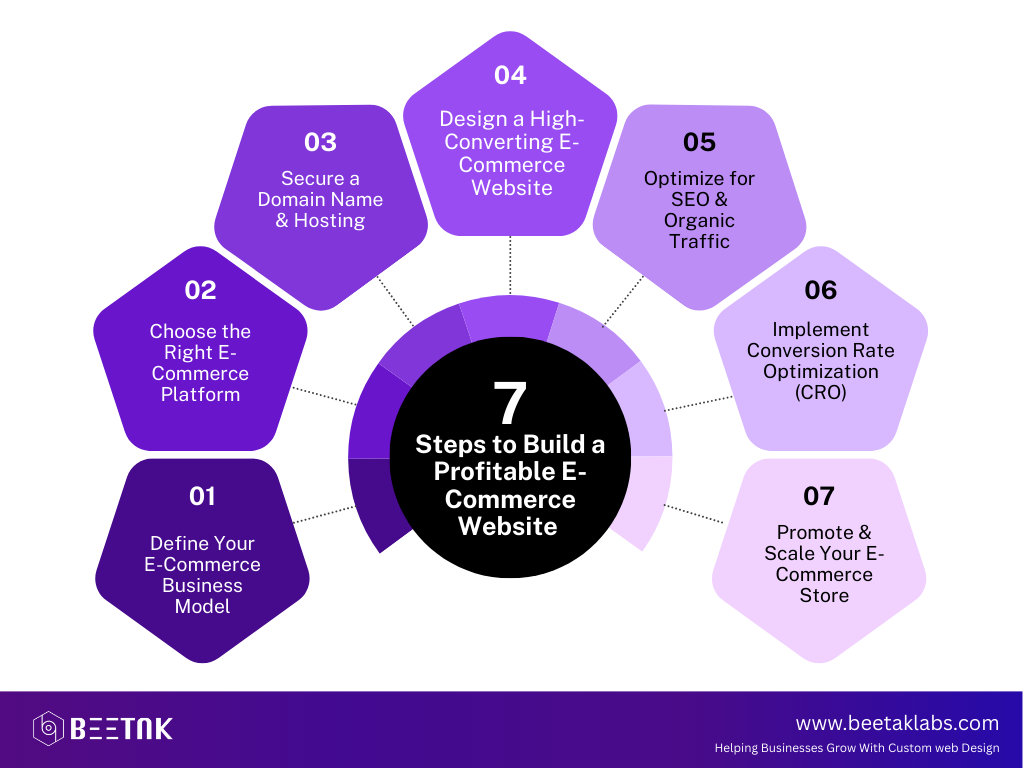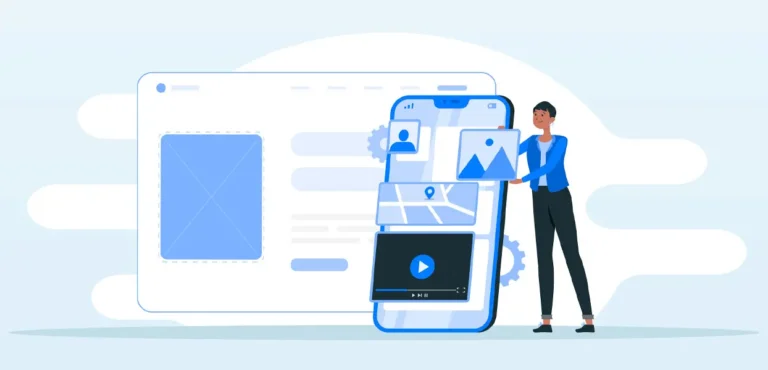Introduction
In today’s digital age, launching an e-commerce website is one of the most lucrative ways to start and scale a business. Whether you’re selling physical products, digital goods, or services, having a well-designed, high-performing website is essential to attract customers, boost sales, and maximize profits.
But how do you build an e-commerce site that not only looks great but also drives revenue and growth? This guide will walk you through the key steps, essential features, and best practices to create a profitable online store from scratch.

Step 1: Define Your E-Commerce Business Model
Before building your website, you need to decide what you will sell and how you will sell it. The three main e-commerce models include:
- Business-to-Consumer (B2C): Selling directly to customers (e.g., clothing, electronics, beauty products).
- Business-to-Business (B2B): Selling in bulk to other businesses (e.g., wholesale products, SaaS tools).
- Direct-to-Consumer (DTC): Selling products directly from manufacturers to customers (e.g., brands like Warby Parker, Glossier).
Tip: Choose a niche with demand and analyze competitors to find your unique selling point (USP).
Step 2: Choose the Right E-Commerce Platform
Your choice of e-commerce platform will determine how smoothly your website runs. Here are the best platforms based on ease of use, customization, and scalability:
- Shopify – Best for beginners, all-in-one platform with built-in tools.
- WooCommerce (WordPress Plugin) – Ideal for customization and SEO-friendly stores.
- BigCommerce – Best for scalability and growing businesses.
- Magento – Powerful but requires development skills.
- Wix eCommerce – Simple drag-and-drop builder for small stores.
Tip: Choose a platform that matches your budget, technical skills, and business needs.
Step 3: Secure a Domain Name & Hosting
A strong domain name (your website URL) enhances branding and credibility. Pick a short, memorable, and brandable name.
- Use .com if possible.
- Avoid numbers, hyphens, or hard-to-spell words.
- Keep it relevant to your niche (e.g., LuxeJewelry.com, FitGear.com).
For hosting, choose a reliable provider that offers speed, security, and scalability. Popular choices include:
- SiteGround (best for WooCommerce)
- Bluehost (beginner-friendly)
- Kinsta (high-performance)
- Shopify (built-in hosting)
Step 4: Design a High-Converting E-Commerce Website
A visually appealing, user-friendly design is crucial for turning visitors into customers. Follow these best practices:
1. Choose a Responsive E-Commerce Theme
Your theme should be:
- Mobile-friendly (over 70% of online shoppers use mobile)
- Fast-loading (Google recommends under 3 seconds)
- Visually aligned with your brand
2. Create a User-Friendly Navigation
- Use a simple, intuitive menu with categories.
- Add a search bar for easy product discovery.
- Keep the checkout process streamlined (no unnecessary steps).
3. Optimize Product Pages for Conversions
Your product pages should include:
- High-quality images (multiple angles & zoom feature)
- Compelling product descriptions (highlight benefits & unique features)
- Clear pricing & stock availability
- Customer reviews & ratings (boosts trust)
- Prominent “Add to Cart” button
4. Implement Secure Payment Gateways
Ensure safe transactions by integrating trusted payment processors like:
- PayPal
- Stripe
- Apple Pay / Google Pay
- Buy Now, Pay Later (BNPL) options like Klarna or Afterpay
Step 5: Optimize for SEO & Organic Traffic
A profitable e-commerce website needs organic traffic from search engines. Implement these SEO strategies to improve rankings:
1. Conduct Keyword Research
Find high-intent keywords related to your niche using tools like:
- Google Keyword Planner
- Ahrefs / SEMrush
- Ubersuggest
Example: If you sell handmade candles, use keywords like “best soy candles” or “non-toxic scented candles”.
2. Optimize Product Pages for SEO
- Include keywords in titles, descriptions, and meta tags.
- Add alt text to images for better search visibility.
- Use structured data (schema markup) for product snippets.
3. Improve Website Speed & Performance
- Compress images using TinyPNG or ShortPixel.
- Use CDN (Content Delivery Network) for faster loading.
- Minimize plugins & scripts that slow down performance.
4. Build Backlinks & Content Marketing
- Start a blog with helpful guides, product comparisons, and trends.
- Partner with influencers & bloggers for backlinks.
- Get listed in online directories & marketplaces.
Step 6: Implement Conversion Rate Optimization (CRO)
More traffic means nothing if visitors don’t convert into paying customers. Improve CRO (Conversion Rate Optimization) with these tactics:
- Offer free shipping & discounts (e.g., “Get 10% Off Your First Order”).
- Use urgency triggers like countdown timers & low-stock alerts.
- Enable abandoned cart recovery emails.
- Display trust badges (SSL security, money-back guarantee).
Step 7: Promote & Scale Your E-Commerce Store
Once your store is live, focus on marketing and growth:
1. Leverage Social Media Marketing
- Run ads on Facebook, Instagram, TikTok, and Pinterest.
- Partner with micro-influencers to promote products.
- Engage with customers via live shopping & social proof.
2. Use Email Marketing to Boost Sales
- Welcome emails for new subscribers.
- Personalized product recommendations.
- Win-back emails for inactive customers.
3. Invest in Paid Advertising (PPC)
Use Google Ads, Facebook Ads, and retargeting campaigns to attract high-intent buyers.
4. Offer Subscription Plans & Memberships
Recurring revenue models increase customer loyalty. Examples:
- Subscription boxes (e.g., beauty, snacks, fitness gear)
- VIP memberships (exclusive discounts, early access to sales)
Final Thoughts: Build & Grow a Profitable E-Commerce Business
Creating a successful e-commerce website isn’t just about having a store—it’s about offering a seamless shopping experience, optimizing for conversions, and using marketing to drive sales.
By following these steps and best practices, you’ll build an e-commerce site that not only attracts visitors but converts them into loyal, paying customers.
Now is the time to launch your online store and start making sales!



